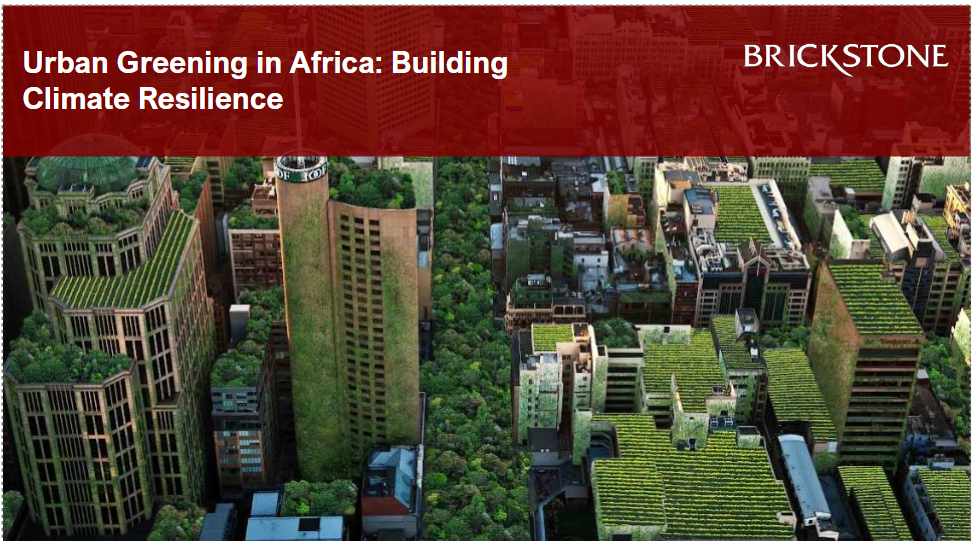Urban Greening in Africa: Building Climate Resilience Together
Urban Greening in Africa: Building Climate Resilience Together
Africa’s rapidly urbanizing cities face mounting challenges due to climate change, particularly from rising temperatures and flooding. In the article “Urban Greening in Africa Will Help to Build Climate Resilience—Planners and Governments Need to Work with Nature,” the authors emphasize that nature-based solutions like urban greening can mitigate these challenges while enhancing the social and economic well-being of African cities. Urban greening refers to integrating green spaces, such as parks, urban forests, and vegetation, into urban planning to provide environmental and social benefits. This piece advocates for using green infrastructure like parks, green roofs, and street trees to combat the issues of heat waves, flooding, and pollution, arguing that nature not only improves environmental sustainability but also enhances the well-being of urban populations.
The article argues that climate resilience can be fostered through greener cities by mitigating heat, improving air quality, and managing urban flooding. African cities such as Kampala, Durban, Lagos, and Freetown have already begun implementing greening strategies that showcase the potential to build a more climate-resilient future. However, the article highlights those obstacles—such as limited policy frameworks, lack of funding, and insufficient collaboration with local communities—still limit broader implementation. In this article, we will highlight the insights.
Insight 1. Urban Greening as a Climate Strategy:
The main thrust of the publication is that green infrastructure can mitigate urban heat, manage stormwater, and improve air quality. These efforts contribute to climate resilience while enhancing the quality of life for residents in African cities. As cities grow, the need for environmentally sustainable solutions like green spaces becomes crucial.
Insight 2. Social and Economic Benefits:
Beyond environmental advantages, urban greening presents several social and economic benefits. Green spaces contribute to better mental health, increase social cohesion, and foster job creation through green industries. They also boost property values, attracting investment and improving overall economic conditions in urban settings.
Insight 3. Barriers to Implementation:
Despite its promise, urban greening faces obstacles such as inadequate policies, limited funding, and minimal technical capacity among African city planners. The article suggests that these challenges need to be addressed by stronger collaboration among governments, urban planners, and local communities to create a broader movement for urban sustainability.
Insight 4. Examples of Success:
The article offers examples of success stories across Africa. Kampala, Uganda, has worked to integrate urban forests, while Freetown, Sierra Leone, is restoring green spaces to combat flooding. These case studies demonstrate how African cities can pursue green urbanism and climate resilience with sufficient policy frameworks and community engagement.
Strengths and Weaknesses:
The article effectively outlines the potential of urban greening in combating climate change. Its strengths lie in offering relevant examples of cities already taking steps toward greener urban planning and linking environmental sustainability with social and economic benefits. However, it could be enhanced by providing more detailed case studies with specific data showing measurable outcomes from the greening efforts. While it touches on the financial and political challenges, the article could benefit from deeper analysis or suggestions on overcoming these barriers.
Supporting Evidence:
The article uses specific examples from cities like Kampala, Durban, and Freetown to demonstrate how urban greening has been applied in practice. These examples, coupled with broader studies on the environmental and economic benefits of green infrastructure, lend credibility to the article’s arguments. However, additional quantitative data and detailed case studies could further strengthen its claims, providing clearer metrics on how urban greening directly impacts climate resilience.
Recommendation:
In summary, the article provides a compelling case for why urban greening is essential to building climate resilience in African cities. It highlights the environmental, social, and economic benefits while also discussing the obstacles that need to be overcome. This publication would be particularly valuable for urban planners, policymakers, environmental advocates, and development agencies seeking to promote sustainable urban development across Africa. While it presents useful insights, it could be more robust with actionable strategies and data-driven case studies. Nonetheless, I recommend this article to anyone interested in urban sustainability and climate resilience strategies.
This article by Brickstone reviews the conversation’s publication on Urban Greening in Africa will help to build climate resilience–planners and government need to work with nature.
Read the complete publication here.





